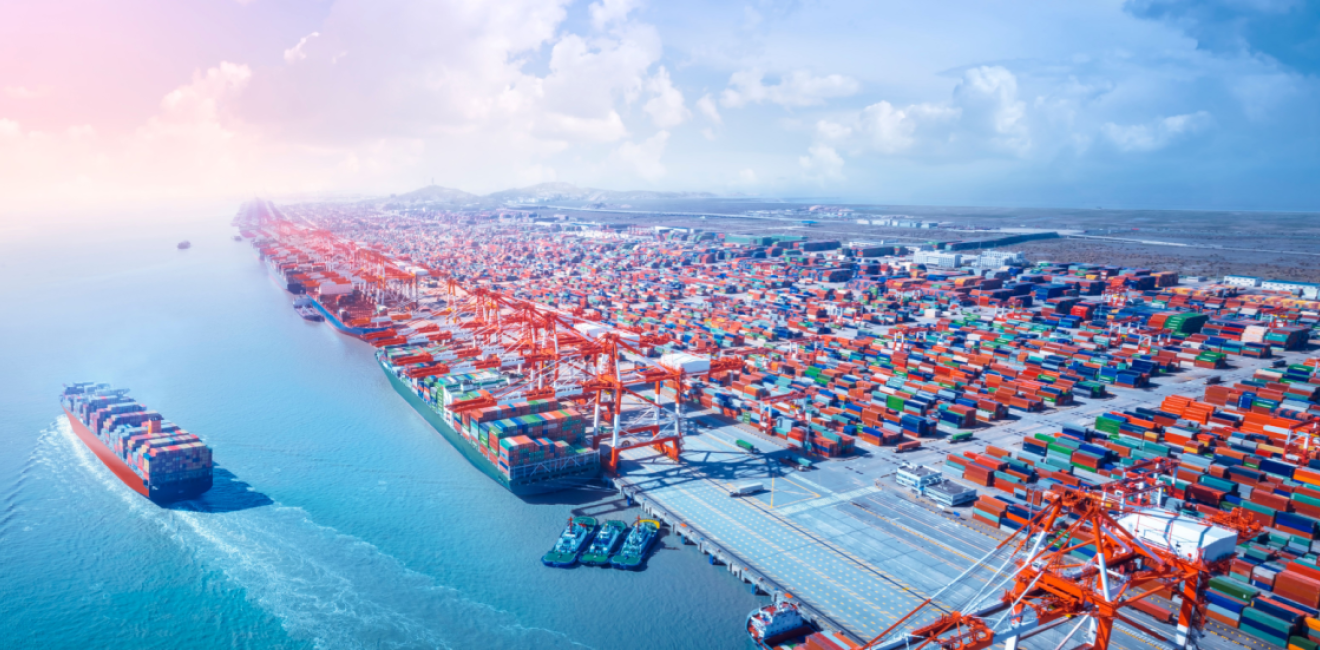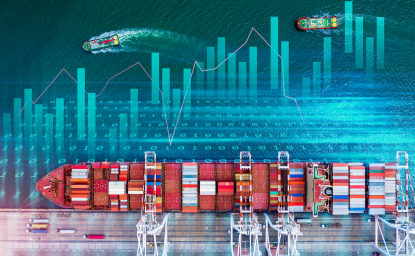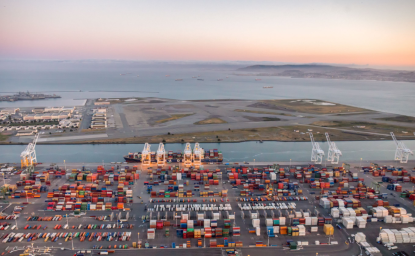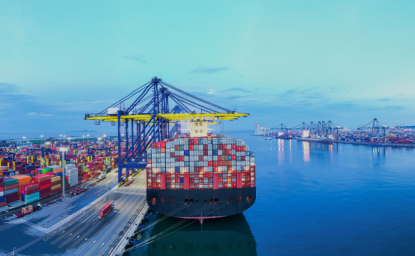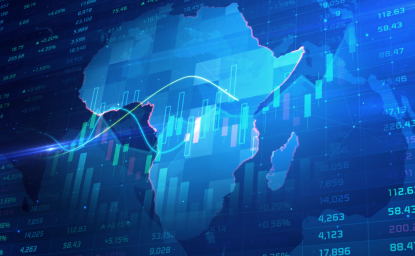Chokepoints Living Up to Their Name
Mark Kennedy
Wahba Institute for Strategic Competition Director
Decades of harmony on the high seas lulled many into forgetting that geographic chokepoints can significantly limit global commerce, putting the ability to buy the latest fashions or the new iPhone at risk, as well as sparking conflict such as we are currently witnessing in Yemen. In recent years, chokepoints have roared back onto the scene and have lived up to their name.
Russia’s invasion of Ukraine, including contesting control of the Black Sea, made clear how important the Turkish Straits of the Bosporus and the Dardanelles are to feeding the world. In the Red Sea, the Houthis have forced recognition of the importance of its chokepoints at either end–the Suez Canal and the Bab-el-Mandeb. Many shippers are instead sailing around the Cape of Good Hope in Africa, increasing the time, cost and carbon footprint of shipping. America achieving greater energy independence reduced focus on the Strait of Hormuz that separates the Gulf of Oman and the Persian Gulf, yet Iran’s recent seizing of an oil tanker there highlights its importance. The People’s Republic of China (PRC) claiming sovereignty in the South China Sea beyond that granted under international law is seen as a flash point, but not always recognized as a chokepoint. Rising tensions between the PRC and Taiwan heighten risk in the Taiwan Strait. In addition to these geopolitical risks, the drought-induced capacity constraints limiting the Panama Canal show Mother Nature has a vote as well.
Yet perhaps the most tense chokepoint is the Strait of Malacca near Singapore. Roughly 80% of China’s maritime energy imports travel through the strait. In 2003, then-PRC Premier Hu Jintao referred to the risk of a naval blockade of such a critical choke point as “the Malacca dilemma.” Interdicting PRC commerce through the strait is often cited as a possible response to an attempt by the PRC to blockade Taiwan.
Seeking to alleviate this risk was among the consequential reasons for the PRC to launch its Belt and Road Initiative (BRI). Besides building energy pipelines to Central Asia, the BRI has invested heavily in the Gwadar Port in Pakistan and the Kyaukpyu Port in Myanmar. Associated rail and road connections to the ports give the PRC land-based access to the Arabian Sea and the Indian Ocean to reduce its reliance on the Strait of Malacca.
Land based options are being promoted for each chokepoint. Mexico is investing in a Trans-Isthmus Railroad as an alternative to the Panama Canal. Thailand is promoting a canal or a land bridge as alternatives to the Strait of Malacca. The US endorsed an Indian proposal for an India-Middle East-Europe corridor as an alternative to the Red Sea. Turkey is considering a canal as an alternative to the Bosporus. The future of many of these initiatives is uncertain. The cost and convenience of land-based alternatives would not be able to compete in normal times with the chokepoint they seek to circumvent.
While melting ice may make the Arctic a shipping corridor, any transpolar sea route is likely to be highly contested. Russia has already built six Arctic naval bases there, creating capabilities to control access to the Northern Sea Route. The PRC gaining observer status on the Arctic Council (even though it does not border the Arctic) and publishing an Arctic Strategy reflects its intense interest in this shortcut from Europe to China. With only 51 miles separating the eastern tip of mainland Russia and the western tip of mainland Alaska, the Bering Strait could become an important chokepoint in the future.
In the quest to achieve an energy transition, ocean shipping faces not only the challenge of going green that raises the costs of crossing the Pacific by about 50%, but also the need for new energy supplies across sea lanes. Like electric cars waiting for an available charger, these new energy depots could become the latest chokepoints.
While the paths to alleviating risks vary by chokepoint, as Wilson Center experts detail below, two cross-cutting priorities are clear: the importance of robust regional diplomacy and a potent US Navy.
Middle East
The US Should Think Long-Term in the Red Sea
Joe Macaron
Middle East Program Global Fellow
The Red Sea corridor between the Suez Canal and Bab al-Mandeb Strait (between Yemen and the Arabian Peninsula) has long been at the center of geopolitical contest. Linking the Mediterranean Sea to the Indian Ocean this strategic waterway runs between the Horn of Africa and the Middle East. The Iranian backed Houthis, who control Yemen’s western coastline, have been launching ballistic missiles and drone attacks in the Red Sea and seizing shipments they claim are either Israeli owned or heading for Israel. They also have targeted US Navy warships. This has disrupted global shipping and added to inflationary pressures.
The US has three interrelated priorities to achieve in this sea corridor: maintain the freedom of navigation, stabilize the global energy market, and manage the power competition. Since mid-November 2023, the Biden administration has pursued these priorities by carrying out joint large-scale military strikes with the UK against Houthi military targets in northern Yemen. The strikes aim to undermine Houthi abilities to disrupt global trade as Iranian proxies are pressuring the US for a ceasefire in Gaza. This waterway, which accounted for 12-15% of global trade last year, saw a decrease in its commercial activities by 42% in November-December 2023. Most shipping companies are doubling the costs and time required for deliveries by going around South Africa’s Cape of Good Hope. However, Saudis continue to send oil tankers and China’s cargo ships continue to cross the Red Sea, escorted by the Chinese Navy. The direct implications are on the European and Asian markets while there a minimal direct impact on the US economy (US shipping primarily uses the Panama Canal). Moreover, it is a tumultuous time for the global energy market, with Ukrainian drones attacking Russian energy facilities, Libyan oil supply dropping due to protests in the country, and Saudi Arabia halting plans to increase oil production.
While the US dominates militarily, it cannot fully deter the Houthis short of a ground intervention in a power competition environment that is not US friendly. Both the US and China have a military base in Djibouti, while Russia will set up a naval base on Port Sudan on the Red Sea. The UAE runs the Aden port and China runs the Djibouti port; both flank the Bab al-Mandeb Strait. Houthis control the western coastline.
There are increasing calls for the US to target Houthis more aggressively and cut all their logistical and intelligence ties with the Iranian regime, which might be effective in the short term. However, Arab and European allies are not willing to partner in this campaign. Overtly deterring the Iranian-backed Houthis means the US would need to be willing to engage in a wider military confrontation with Iran. This also might impact the ongoing peace process in Yemen and ultimately, Saudi energy security. While targeting the Houthis in the short term is a limited deterrence option, the US should: 1) push for a ceasefire in Gaza with a viable conflict resolution map, which might restore the US global leadership in the region; 2) advance the Yemen peace process and use diplomatic pressure to ensure that the Houthis will no longer disrupt international maritime trade; and 3) find a long-term mechanism that includes gulf countries and China to ensure the freedom of navigation in the Red Sea. Resolving this maritime crisis requires recognizing that the trigger point is in Gaza and that the US global leadership is in question if it does not maintain stability across the region, not only in the Red Sea.
Regional Engagement and Infrastructure Investment Vital to Resilience of Turkish Straits
Yusuf Can
Middle East Program Coordinator
In recent years, global geopolitical dynamics have thrust certain regions into the spotlight, shedding light on the critical importance of secure global shipping lanes. This significance is underscored by events such as the ongoing war in Ukraine and the war between Israel and Hamas. These incidents have underscored the indispensable nature of secure pathways for international trade and energy flow. Among these passages, the Turkish Straits, comprising the Bosporus and Dardanelles, emerge as pivotal players in the global maritime landscape.
Linking the Black Sea with the Mediterranean, the Turkish Straits are vital conduits for Turkey and critical arteries for transporting global trade and energy resources, including oil and natural gas shipments. For decades, the US has heavily relied on these routes for the seamless movement of goods worldwide, often taking their security for granted. However, their strategic importance has become increasingly apparent, given the current geopolitical volatility.
Approximately 4% of the world’s crude oil trade traverses these straits, highlighting their significance as a crucial channel for energy supply, especially from the Middle East and Azerbaijan to Europe. Turkish Strait’s strategic positioning allows Ankara to assume a pivotal role during times of crisis, as demonstrated by its facilitation of the grain deal between Ukraine, Russia, and the global community, which proved instrumental in sustaining the global food supply. Turkey’s navigation of its relationships with both Western and non-Western powers, often controversially, further emphasizes the importance of these straits.
Recognizing the strategic importance of the Turkish Straits, the US would benefit from adopting a comprehensive approach that integrates diplomatic efforts, investments in infrastructure, and strengthened alliances with nations along vital maritime corridors, particularly in the Black Sea region. Countries surrounding the Black Sea, from Georgia to Romania, are in the process of aligning themselves with NATO or the EU, presenting opportunities for increased US influence in the area. This strategic approach can help counterbalance Russia’s and China’s expanding presence and ensure the US maintains significant sway over global trade dynamics.
Central to this strategy is diplomatic engagement with Turkey to enhance supply chain resilience and ensure uninterrupted passage through the Turkish Straits on par with the Montreaux Convention of 1936. This entails supporting infrastructure enhancements and collaborative initiatives to mitigate regional conflicts and natural disasters. Given the Turkish Straits’ critical role in facilitating worldwide commerce and energy supplies, securing and optimizing their efficiency is imperative in an era marked by geopolitical uncertainties and competitive international relations.
Latin America
Mexico’s Trans Isthmus Railroad – An Alternative to the Panama Canal?
Andrew Rudman
Mexico Institute Director
Mexican President Andrés Manuel López Obrador (AMLO) has invested heavily in four large infrastructure projects during his administration. Of these, much has been written about the Tren Maya, which provides freight and passenger rail service to the previously underserved Yucatan Peninsula, the Dos Bocas refinery, and the Mexico City airport which controversially replaced a project started by AMLO’s predecessor. The project that may ultimately prove to be most economically impactful, however, is perhaps least-well known – the Trans-Isthmus Railroad. The 200-kilometer line connects the ports of Salina Cruz, Oaxaca on the Pacific and Coatzacoalcos, Veracruz on the Gulf of Mexico and links to the Tren Maya railroad on the Yucatan Peninsula - offering an alternative to the Panama Canal to move cargo from the Pacific to the Atlantic and on to the US East Coast.
The trans-isthmus will not replace the Panama Canal though it would provides an alternate route it could spur economic development in Mexico’s poorer south/southeast and reduce costs. A recent Washington Post op-Ed pointed out the significant impact of climate change on the water levels in the Panama Canal and the reservoir that feeds it. Wait times of up to three weeks to access the Canal due to the decreased water levels could be mitigated by diverting some cargo to the trans-isthmus which, ironically, was built in 1907, prior to the opening of the Panama Canal. In part because the trans-isthmus crossing is not dependent on rainfall, trans-oceanic transit times can be reduced by 10-18 days in comparison with transit through the Canal.
Economic development of southern Mexico in response to McKinsey’s “two Mexicos,” has been a goal of successive Mexican administrations, including AMLO’s. The south/southeast of Mexico could become a new locus for nearshoring-driven economic growth and a driver of job creation which could potentially reduce the push to migrate North. Mexico has embarked on a concerted effort to attract manufacturing in sectors such as semiconductors, auto parts, and electronics to the isthmus so that it can be more than a transit zone. The new industrial corridor, which comprises 10 industrial parks, has received at least 52 letters of intent from Mexican and foreign enterprises willing to invest US $4.5 billion.
While intensification of the trans-isthmus offers potential for growth, it may be hampered by lack of access to energy which could be addressed through development of renewables (wind and solar). In addition, the region lacks adequate water and gas infrastructure to support industrial development.
The success of the trans-isthmus, as a transit link and a development pole, is hardly guaranteed. While the potential is clear, it will require action on the part of the current and future Mexican administrations (taking office on October 1, 2024) to capitalize on the potential.
Deforestation Impacting the Panama Canal
Monica de Bolle
Peterson Institute for International Economics Senior Fellow
To consider actions the US might take, it is critically important to understand what is happening in the Panama Canal. For decades, we’ve known that climate change could affect the canal, especially since it relies on consistent rainfall to maintain the water levels of its artificial lakes. Nonetheless, we have sleepwalked into a situation where lake water levels are at their lowest since the Panama Canal Authority first began recording the data in 1965.
Why? Many have pointed to the intense and prolonged El Niño that has afflicted the planet since last year. To be sure, more pronounced El Niño cycles have long been associated with climate change. More recently, research has shown that deforestation in the Maritime Continent (Indonesia, Borneo, New Guinea, Philippine Islands, Malay Peninsula) contributes to stronger and more frequent cycles of warming waters in the Pacific Ocean. In a recent piece published by the Peterson Institute for International Economics, I argue that existing research also supports the notion that Amazon deforestation contributes to a drier climate to the north, potentially affecting the Panama Canal.
What’s to be done? We need coordinated measures to curb man-made tropical forest loss. The US should devote attention to its own backyard – namely, Central and South America – to help countries formulate and cooperate on a systematic plan to halt Amazon deforestation. It is not just about throwing money at the problem – that has been tried with the Amazon Fund but thus far, failed. What is needed are greater efforts at monitoring deforestation in real-time, as the National Aeronautics and Space Administration (NASA) and Brazil’s National Institute for Space Research (INPE) did in the 2000s, and the formulation of punitive mechanisms aimed at putting an end to illegal logging, mining, and cattle-raising. These mechanisms need to be applied with the same criteria and intensity in all the Amazon countries. The stakes couldn’t be higher: failing to stop deforestation risks allowing a major global trade route to become extinct, apart from catastrophic climate consequences associated with permanent changes to crucial hydrological cycles – the rainfall that irrigates crops and ensures the subsistence of millions who will otherwise flee north, to the US.
Asia
Navigating Maritime Security and Shipping in the Strait of Malacca Amidst Growing Regional Tensions
Lea Thome
Kissinger Institute on China and the United States Schwarzman Fellow
While much attention is focused right now on the Red Sea crisis and the issue of maritime security there, this prompts the question of what challenges maritime shipping and security may face in other parts of the world. The Strait of Malacca, conveniently located between Malaysia and Indonesia and connecting the South China Seas with the Indian Ocean, handles US $3.5 trillion dollars worth of shipping passing through its waters, including 2/3 of China’s maritime trade volume.
With the Strait of Malacca being closely located to China’s neighborhood, and with China’s strong interest in the region, the US should work to ensure that maritime shipping lanes and security remain free and open for all. The US has already forged strong historic security partnerships with countries like the Philippines, Thailand, and Japan, and has worked on strengthening these ties in the past years, such as by adding new sites to the US-Philippines Enhanced Defense Cooperation Agreement and by elevating new partnerships in the region with Vietnam for example.
However, beyond enhancing military alliances and partnerships, the US needs to shift its attention towards supporting its commercial partnerships and supply chains in the Strait of Malacca. With China now being involved in 92 port projects across the world and with many of them located in the Indo-Pacific region, American companies have long been absent in international port and maritime shipping projects. Recently, the DFC took a first step of action in the Strait of Malacca by issuing a half a billion dollar loan for the construction of a new deepwater container terminal at the Sri Lankan port of Colombo.
This action needs to be followed up by the US and its allies – even those not directly located in the region but with a keen interest in keeping maritime shipping routes secure – by a commitment to continue investing in ports and shipping around and in the Strait of Malacca. The US government also needs to further explore how supply chains resilience and open maritime shipping lanes can be maintained amidst rising geopolitical tensions in the region, in times when North Korea continues its testing of new missiles, China has been working on rapidly modernizing its military in recent years, and as actors in and outside of the region work on navigating these uncertainties.
Pathways for Shipping Corridor Engagement in Southeast Asia
Dr. Prashanth Parameswaran
Wahba Institute for Strategic Competition Global Fellow
Southeast Asia is a critical front in any global effort on secure shipping corridors. First, the region is home to strategic sea lanes including the Straits of Malacca and the South China Sea. The latter accounts for anywhere from a fifth to a third of global commerce and implicates four regional claimants in Brunei, Malaysia, the Philippines and Vietnam (Indonesia has overlapping maritime claims with China though not officially a claimant). Second, Southeast Asian states are actively involved in initiatives to manage evolving regional and global shipping dynamics. Two recent examples are Thailand’s ambitious proposed land bridge that could bypass the Straits of Malacca and Singapore’s contribution to Operation Prosperity Guardian in the Red Sea. Third, China has attempted to make geopolitical inroads in this space. Some of this is rooted in Beijing’s longtime quest for maritime routes, as evidenced by projects like the Kyaukphyu port in Myanmar which offers an outlet to the Indian Ocean or the long-elusive Kra Canal through Thailand which could reduce China’s perceived overreliance on the Straits of Malacca. Beijing has also tried to invest directly in ports or other strategic facilities. While much of the focus has been on its gains in Cambodia’s Ream naval base, China has made attempts in other cases as well including purchasing stakes in Malaysia’s Kuantan Port and trying to take over the Philippines’ Subic Bay shipyard.
A forward-leaning US approach to this area in Southeast Asia would utilize several avenues. The first is proactive capacity-building for countries in port development or related strategic infrastructure. Occasional examples already exist, be it the US private sector’s role in the takeover of the aforementioned Subic Bay shipyard or US government assistance to the previous Myanmar government to scale down the Kyaukphyu port project. The second is utilizing sectoral partnerships. One notable example is the Singapore-Japan green and digital shipping corridor. The corridor, the first of its kind globally, opens space for cooperation not only in decarbonization and digitalization, but also port clearances and maritime cybersecurity risk management. The third is assisting with government planning in the shipping space. U.S. partners are already involved in some aspects, be it the European Union’s support for Malaysia’s assessment of the strategic port of Lumut given Malaysia’s position between the Malacca Straits and South China Sea and even Australia’s involvement in thinking through dry ports for landlocked Laos. A fourth is utilizing regional institutions to seed mutually beneficial ideas. For instance, the recent momentum injected by Indonesia into the maritime realm for the Association of Southeast Asian Nations (ASEAN) could offer opportunities for Washington to engage on shipping-related issues as part of an evolving regional agenda and wider effort to concretize a more maritime outlook.
Enhanced Force Structure and Regional Relations Vital to Securing Strait of Malacca
Lucas Myers
Asia Program Senior Associate
The Malacca Strait unites the two oceans of the Indo-Pacific. Although there are other straits within the Indonesian archipelago such as Lombok (near Bali) and Sunda (between Java and Sumatra), the sea lines of communication passing through the Indian Ocean largely transit through Malacca. Its security is therefore of prime strategic importance.
Prolonged disruption to traffic through the Strait would jeopardize the global economy and US military effectiveness in the region, as well as energy security for US allies and partners, notably Japan and South Korea. Each year, $3.5 trillion USD in global trade transits on 90,000 vessels through the Strait, representing approximately 21 percent of international trade. Anyone flying into Changi Airport can attest to the throngs of container ships perpetually navigating the waterways near Singapore. The Malacca Strait is also critical for US military force posture in the region. US naval vessels regularly sail through the Strait on deployments or in transit.
The Malacca Strait will therefore prove pivotal in any armed conflict with China in the South China Sea, East China Sea, or Taiwan Strait. Beijing already devotes significant attention to its “Malacca Dilemma,” referring to a potential naval blockade of the strait. Almost 80 percent of China’s imported oil passes through the strait, driving Chinese policymakers to pursue strategic alternatives bypassing Malacca via Belt and Road infrastructure projects in Myanmar and Pakistan, as well as opening the Northern Sea Route, among others. China’s growing—and highly alarming for India—naval presence and port access in the Indian Ocean aims to secure its vital sea lines of communication through Malacca.
Protecting access to Malacca and denying it to China during a wartime scenario is paramount for the United States. This requires a deeper focus on Indo-Pacific force posture and fostering positive relationships with strategically placed states.
Under the Biden administration, the United States has made solid progress on regional force posture. It signed a submarine deal with Australia and the United Kingdom, expanded and accelerated military access in the Philippines, deployed B-52 bombers to Indonesia in a signal of improving security ties, began preparing to disperse US forces throughout Japan’s Southwest Islands, and forged a defense agreement with India on maritime repair and logistics, among other initiatives in the Pacific.
However, more can be done to enhance US force posture in Southeast Asia and the Indian Ocean. Amidst competing strategic priorities in the Middle East and Europe, the United States should prioritize new military access agreements, prepositioning equipment and supplies, and enhancing defense ties with allies and partners on both sides of the Malacca Strait.
The second necessity is to deepen overall relationships with regional states, most of whom prefer to hedge between the United States and China. In all likelihood, they would assert firm neutrality in the event of armed conflict in the Indo-Pacific, and some may chafe at armed vessels transiting through nearby waters, including the Malacca Strait. Indeed, although military passage through archipelagic waters is affirmed in international law, AUKUS triggered concerns in Indonesia and Malaysia. For Washington, every effort must be expended to foster closer ties to the maritime states of Southeast Asia to ensure access to Malacca during a conflict scenario, which includes efforts to finance infrastructure projects and enhance economic engagement to offset China’s influence.
Above all, US and allied and partner commercial and naval vessels must have the freedom to sail through the Strait no matter the circumstances.
The South China Sea and the Strait of Malacca Face Geopolitical Risks
Klaus Larres
Global Europe Program and Kissinger Institute on China and the United States Fellow
Some of the most important shipping lanes in the world are the sea lanes of the South China Sea. They are crucial for upholding global supply lines. It has been estimated that perhaps one third of global shipping passes through the naval routes of the South China sea with an annual value of $3-5 trillion. In fact, the adjacent Strait of Malacca, which goes passed Singapore and the Malaysian coast, is the shortest and thus cheapest way to transport goods between the Pacific and Indian oceans. Usually, oil and minerals and other natural resources are transported north and food and manufactured wares are moved south.
The Strait of Malacca is particularly important to China, Taiwan, Japan and South Korea. 60 per cent of China’s global trade is conducted by sea; the respective number for Japan is 42 per cent while only 14 per cent of the maritime trade volume of the US goes through the area. Thus, the South China sea is crucial for China, which makes Beijing think twice about endangering the openness of these important sea lanes. The continued free flow of trade through the South China Sea, including the Strait of Malacca, is clearly in China’s interest. The fearmongering in the western media about the potential that China may well disrupt or even close the free flow of trade in the South China Sea for commercial reasons (such as putting economic pressure on the US and its allies and partners to counter US imposed exports controls or tariffs on Chinese products) is unrealistic.
Nevertheless, this basic commercial fact is made more complicated by two territorial and geopolitical issues concerning Taiwan and the disputed reefs, rocks, and mostly uninhabited islands within China’s unilaterally imposed “Nine-Dash-Line” in the South China Sea.
Taiwan: In the context of its One-China policy and repeated claims throughout the last 50 years, starting with the 1972 Shanghai Communique, one of China’s top geopolitical objections is the unification with the Republic of China on Taiwan. While Beijing wishes to bring this about by peaceful means, it has not ruled out the use of force to achieve this objective. In fact, achieving the unity of China is such a strong nationalist ambition, which is greatly supported by the vast majority of China’s 1.4 billion people, and a prime personal aspiration of current CCP leader Xi Jinping, which might overrule other considerations. Sound commercial and economic reasoning may well become sidelined, if Beijing arrived at the conclusion that the time was ripe to attempt the unification of the motherland.
As was laid down in the 1979 Taiwan Relations Act, the US is committed to preserving the current status quo. The Act specified that "the United States will make available to Taiwan such defense articles and defense services in such quantity as may be necessary to enable Taiwan to maintain a sufficient self-defense capability." The Act obliged the US "to provide Taiwan with arms of a defensive character” and maintain “the capacity of the United States” which will enable Washington “to resist any resort to force or other forms of coercion that would jeopardize the security, or social or economic system, of the people on Taiwan." Still, as the US has not clearly promised to get involved militarily if the PRC invaded or attacked Taiwan or used other means of coercion, such as boycotts and embargoes, Washington’s strategy has been rightly called a policy of “strategic ambiguity.” The Biden administration, however, has increasingly moved away from it and has become more explicit in its support of Taiwan in case of a military crisis.
At present, however, it appears that China does not (yet) have the military means to bring about unification with Taiwan. An invasion of Taiwan would be a great military risk for Beijing. An economic blockade of the island would be an equally formidable geopolitical gamble. Moreover, Beijing does not seem to have entirely given up on achieving unification with Taiwan by peaceful ways though in view of the Taiwan population being increasingly disinterested in unity with China, time might be running out in the view of the CCP leaders in Beijing. It is thus geopolitics which may endanger the free flow of trade in the South China Sea in the future rather than purely economic interests.
South China Sea: This also applies to the disputes over the reefs, rocks and islands in the South China Sea. Although a binding ruling of the UN Permanent Court of Arbitration (PCA) in The Hague in July 2016 declared that China had no historical claims to the South China Sea and no right to impose a Nine-Dash-Line within the South China Sea, Beijing sees this very differently and has ignored the ruling. China claims everything within its artificially drawn up Nine-Dash-Line in the South China Sea (almost 90 per cent of the entire sea) as being within its national jurisdiction. Yet, countries such as the Philippines, Malaysia, Brunei, Vietnam also claim some of the reefs and rocks in the South China Sea, and the surrounding waters, as part of their national territory. Particularly disputed are the waters and rocks around the Spratly islands and the Second Thomas Shoal.
Incidentally, these claims have relatively little to do with the existence of natural resources within these waters. The natural resources of the South China sea, mostly oil and natural gas, are not as rich and as voluminous as was assumed in the past. These resources are also mostly located at the margins of the South China Sea and not beneath some of the disputed rocks, reefs and islands in the South China Sea.
Thus, for commercial and economic reasons China is highly interested in keeping the important sea lanes in the South China Sea open and free. Yet, geopolitics may interfere. Still, if the disputes about Taiwan and the reefs, rocks and islands in the South China Sea can be resolved by peaceful means, it is likely that trade will flow freely and uninterrupted through the South China Sea and the Strait of Malacca.
The Strait of Malacca: Relations With Indonesia Are Pivotal
Sam Barr
Wahba Institute for Strategic Competition Global Fellow
The Strait of Malacca is a pivotal Sea Line of Communication (SLOC) for many Indo-Pacific nations, including China. For example, roughly 80% of China’s maritime energy imports travel through the Strait.
This volume and the Strait’s location and geography pose a significant risk for Beijing. In 2003, then Premier Hu Jintao referred to the risk of a naval blockade of such a critical choke point as “the Malacca dilemma”.
But acknowledging a problem is not solving it. China has in recent years looked to find alternatives to transiting through the Strait but it remains a vital SLOC. Economists have found that rerouting trade routes has a significant impact on economic output. Put simply, China clearly sees the costs of a significant rerouting of shipping as too high – for now.
The Strait of Malacca runs next to the Indonesian archipelago, and as such Indonesia plays an outsize strategic role regarding goings-on in the area. Relations with Indonesia are thus critical for any power looking to exert influence in the region.
Both the US and China know this. Unlike the South China Sea more broadly, the Strait is distant from China’s shores, and it cannot rely on contested territorial claims to provide cover for its actions in the Strait as they do closer to home. This means that both China and the US rely on soft power diplomacy to exert influence in the region.
China is Indonesia’s largest trade partner, and Chinese President Xi Jinping met with his Indonesian counterpart Joko Widodo in 2023 to celebrate ten years of strategic partnership. However, Indonesia has bristled at China’s approach to the South China Sea. The relationship is best characterized as one of economic necessity rather than mutual trust.
Since the Obama-era “pivot to Asia”, US relations with Indonesia have been steadily improving. A 2021 Lowy Institute poll found that 49% of Indonesians see China as a security threat, compared to 43% seeing the US as a threat. This is an improvement from 2011 where those figures were roughly reversed. The Comprehensive Strategic Partnership announced by Presidents Biden and Widodo last November further elevated the relationship between the two nations. Building trust takes time and hard work. The US has worked assiduously to improve its standing in the region, but more is required.
As tensions rise in other parts of the world, the US relationship with Indonesia, as the world’s largest Muslim-majority democracy, is crucial for numerous reasons. The Strait of Malacca is one of them. And if 2024 throws up as many curveballs as 2023, we may be hearing a lot more about this narrow stretch of ocean.
Arctic
The Arctic Shipping Silver Bullet?
Dr. Rebecca Pincus, Polar Institute Director
Dr. Jonathan Caverley, US Naval War College's Center for Naval Warfare Studies Professor
Shipping corridors are the arteries of the global economy: critical sea lanes that, if severed, would result in rapid mortality. The most heavily-traveled shipping corridors pass through maritime chokepoints, where natural or political disaster can wreak havoc on the global economy in hours.
As sea ice retreats in the Arctic Ocean, it is tempting to hope that trans-Arctic shipping will provide relief to crises further south. Between northern ports in Asia, Europe, and North America, shipping across the Arctic reduces distance by about 2500 nautical miles versus the Suez Canal route. Retreating sea ice means both longer navigational seasons and thinner coverage, making for easier sailing for more vessels. There are two major Arctic shipping lanes: the Northern Sea Route (NSR or Northeast Passage) across Russia’s northern coast, and the Northwest Passage across Canada. Both are becoming more accessible, although the NSR is opening faster.
While ship traffic is increasing in the Arctic, most of this increase remains tied to regional resource development. This includes fishing vessels, tankers, dry bulk carriers serving mining operations, and general cargo ships resupplying local communities. Much of the increase is linked to construction of Russia’s industrial projects along its Arctic coast, including the massive Yamal LNG project.
The number of voyages across, rather than to or from, the Arctic, remains vanishingly low. Multiple reasons exist for the absence of transit traffic, the shipping that matters most for the global economy:
- Draft restrictions in both the Northern Sea Route and Northwest Passage limit the size of ships, even as shipbuilders build increasingly massive cargo and tanker ships.
- Despite shrinking sea ice, the summer season of easiest navigation (lowest ice extent) still lasts barely a few months. In winter, ships require icebreaker escort. In spring and fall, unpredictable ice thaws and freeze-ups can create uncertainty and chaos.
- Even in summer, the Arctic’s extreme climatic conditions, amplified by environmental change, challenge global maritime business models built on a just-in-time and highly predictable schedule. There are no guarantees of on-time delivery when sailing through the Arctic.
- The International Maritime Organization imposes additional training and operational requirements under the Polar Code, and additional insurance costs are likely.
It should be clear that Arctic shipping lanes are not a quick fix to shipping problems in Panama and the Red Sea. In the Panama Canal, we see the start of a problem—climate change-driven drought—that will only intensify in coming decades. In the Red Sea, attacks on shipping are the kinetic manifestation of a political problem between Iran and the West.
Arctic shipping is not a panacea for the Red Sea because it is simply trading one political problem for another: Iran for Russia. Resolving the current shipping crisis in the Red Sea is far less expensive than the manifold costs that would be borne in adapting global shipping to depend on a major artery through Russian waters. Moreover, rail transportation, while less efficient than seaborne shipping, can provide a cheaper, more politically effective relief valve, especially with more investment. Europe weathered the Suez Canal blockage in 2021 largely because it has such a well-developed ground transportation network.
In contrast to the Middle East, the Panamanian chokepoint has no political solution. The same forces causing Arctic Sea ice to retreat, climate change, are also gradually and probably inevitably reducing the Canal’s throughput. The Canadian government has shown no interest in opening the Northwest Passage to commercial shipping, nor would it be feasible to route large container ships through the winding, shallow waterways of the Canadian Arctic archipelago. Yet the Panama Canal is vital to the US economy, particularly for shipping farm products from the East Coast to Asia. The US could press Canada to facilitate Arctic shipping, but only after considering the relative costs to other potential solutions, from more transcontinental rail to reengineering the Canal. This dilemma illustrates the climate future: picking a least-bad solution among a set of terrible options.
When it comes to Arctic shipping, it would be wise for the US government to take its cues from the private maritime industrial sector. The shipping, energy, and insurance industries have developed a sophisticated market infrastructure that processes information quickly, anticipates future demand relatively effectively, and rapidly responds to crises. If and when the industry begins the long process of developing ice-capable fleets, then governments can respond. But until then, easier political and economic alternatives likely exist.
Green Corridors
Green Shipping Corridors Present Strategic Opportunities
Jeffrey Kucik
Wahba Institute for Strategic Competition Global Fellow
In December of 2023, the US announced plans with Denmark to explore the feasibility of new green shipping corridors with developing countries across Africa, Central America, and Southeast Asia. The partnership with Denmark is just one of several new initiatives under the Department of State’s 2022 framework to promote more sustainable transportation. But what are “green corridors”—and will they advance or impede America’s strategic interests?
Green corridors are maritime routes that rely on zero-emission fuels to reduce shipping’s carbon footprint. These initiatives have grown in popularity at a time when the shipping industry revenue suffers from overcapacity and disruptions to key routes, most notably the Panama Canal and Red Sea.
Unsurprisingly, the main impediment to greener transportation is the cost. Relatively few ships in operation today are outfitted to carry or consume alternative fuels. And even if they were modernized, zero-emission lifecycle fuels are much more expensive than traditional energy sources. Taken together, it’s estimated that transitioning to green shipping could widen the cost spread per container by $200, an increase of approximately 50% to get across the Pacific.
The general consensus is that these high costs will deter the private sector from meeting the International Maritime Organization’s pledge to cut emissions in half by its 2050 target date. As a result, government action, most likely in the form of direct subsidies to firms owning and operating vessels, will be required to offset the high costs. All G7 countries have already announced (or implemented) subsidies for green energy that could aid in the transition.
The good news is that we are still early in this process and there is still time to make the necessary investments with broader strategic goals in mind. There are opportunities to pursue three goals:
- Invest in supply chain resilience. Feasibility studies should prioritize key relationships, including the shipping lanes that connect early stages of semiconductor manufacturing. New plans linking the ports of Los Angeles and Long Beach to Singapore may help boost long-term stability in these critical industries.
- Consider multiple fuel types and sources. Green ammonia is the leading alternative fuel but there are also other options. Costs permitting, investing in a diversity of fuels can reduce overreliance on specific suppliers.
- Locate bunkering infrastructure in allied partners. Studies show that Australia, India, and Brazil are the among the optimal places to invest in burgeoning green fuel capacity. Shoring up these partnerships now through joint investments can help ensure predictability in shipping routes currently facing disruptions.
Of course, market forces will always shape which routes are the busiest and most profitable. Green corridors aren’t about remapping shipping lanes from scratch. But there is an opportunity to invest today in infrastructure that means future routes will be greener—while also safer and more secure.




